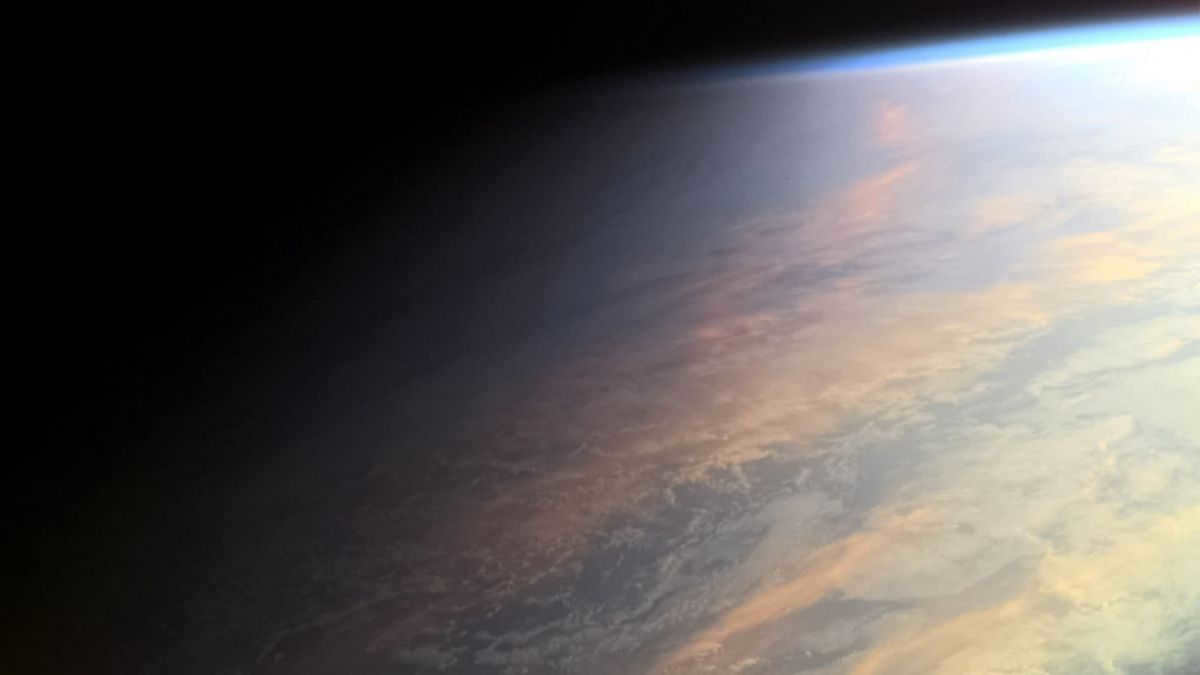
This article delves into the topic of twilight and its associated concepts such as dusk and dawn, the golden hour, mode time, and total darkness. We will explore the distinctions between these terms, their various classifications, and provide guidance on how to accurately determine their timing based on your specific location. Let’s gain a comprehensive understanding of these terms once and for all!
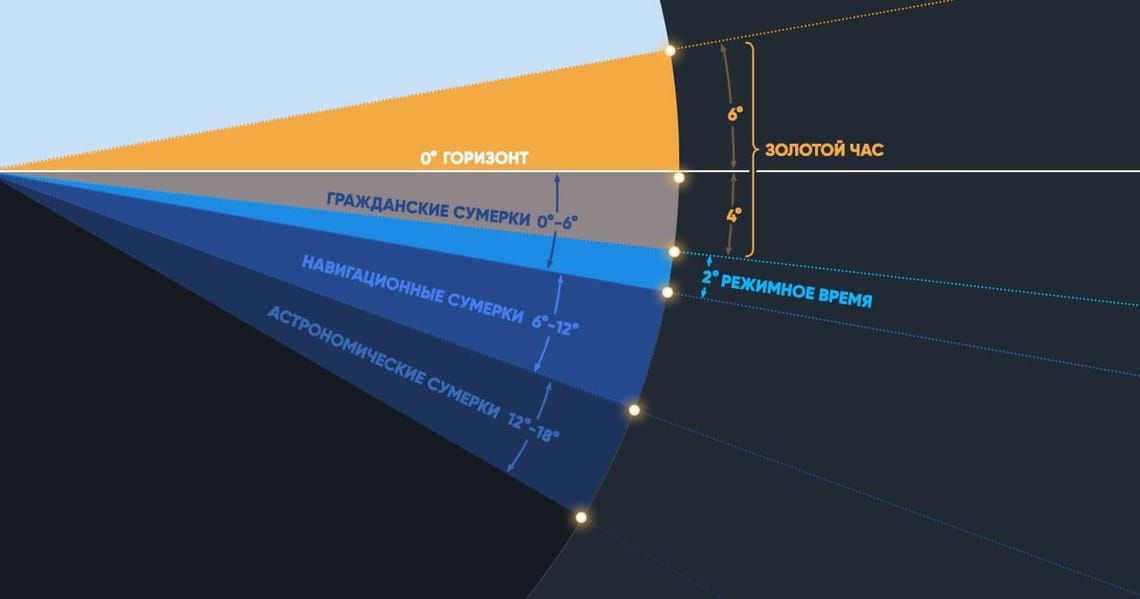
When does twilight occur? What are the different types of twilight? What is the golden hour? Our infographic provides answers to these questions and more.
What exactly is twilight?
Twilight refers to the period of time when the sun is already below the horizon but still partially illuminates the sky. Twilight happens because the Earth has an atmosphere that scatters light, causing our planet to remain illuminated even when the Sun is not visible.
Twilight Varieties
There exist three distinct types of twilight, namely civil, navigational, and astronomical. These twilight variations occur in a sequence, with each type being determined by the Sun’s geometric center’s position below the horizon:
- Civil twilight: 0–6°
- Navigational twilight: 6–12°
- Astronomical twilight: 12–18°
The time when the Sun descends below 18° is referred to as night.
This is the most luminous phase; it is the image that comes to mind for most people when they mention twilight. Civil twilight occurs right before sunrise or after sunset. At this particular time, the horizon line is distinctly visible, and only the most brilliant stars and planets can be seen in the sky. In numerous countries, regulations mandate the use of street lights and low beam headlights on vehicles during civil twilight.
Immediately following sunset, the sky remains quite bright and glistens with an array of colors. To capture the diverse shades in the sky, it is advisable to capture the very commencement of civil evening twilight.
Twilight for Navigation
This marks the second phase, where the line that separates the Earth and the sky becomes less distinct. This concept dates back to a time when sailors relied on the stars to guide their way. During twilight for navigation, a multitude of stars become visible, allowing one to determine their location based on their positions.
During this period, urban areas are already fully illuminated by artificial light, making it an ideal time for city photography. For astrophotography enthusiasts, there is a chance to capture the full moon just above the horizon. This presents an opportunity to photograph dark silhouettes juxtaposed against the backdrop of the moon.
Astronomical twilight
At the point when the outside is nearly totally dark and the horizon is scarcely distinguishable, astronomical twilight emerges. The Milky Way starts to show up in the sky, and even faint stars and planets can now be seen without the aid of a telescope (unless the Moon is illuminating the sky, obviously). However, galaxies, nebulae, and star clusters are still most effectively observed during complete darkness, when the Sun has already descended below 18° below the horizon.
This is an ideal time for capturing photographs and making observations of celestial bodies. If the Milky Way is visible from your location (confirm with Ephemeris for the exact time), try capturing the awe-inspiring beauty of this galaxy.
When does twilight occur?
The timing of twilight varies across different regions, so there is no universal moment when twilight begins. So, how can you determine the occurrence of astronomical twilight? Use either the app or website.
- Sky Tonight is an advanced astronomy app designed for observation purposes. Within the app’s calendar, you will find comprehensive charts displaying twilight times, daylight hours, and total darkness specific to your location.
- Ephemeris is a convenient tool for planning outdoor photography. It provides precise timings for civil, navigational, and astronomical twilight, calculates golden hour and mode time, and offers detailed information on the visibility of the Milky Way and more.
- Sun Surveyor – an augmented reality application that displays the paths of the Sun and Moon. It is a useful tool for visualizing and planning future photographs.
- Photographer’s Ephemeris – This map app provides calculations for the trajectories of the Sun, Moon, and Milky Way. It can assist photographers in planning nature photo shoots with optimal natural lighting conditions.
- Time and Date – This website offers comprehensive information on sunset and sunrise times for your specific location.
- Sun Today – A resource that provides a wide range of information about the Sun, including sunrise, sunset, twilight, noon, and more.
How long is the duration of twilight?
The duration of twilight varies depending on the latitude, time of year, and weather conditions. At the equator, the shortest twilight lasts for about 24 minutes after sunset, while at the poles, it can last for approximately six weeks.
What do dawn and dusk refer to?
Dawn and dusk are specific times that depend on the position of the Sun in relation to the horizon. There are three types of dawn and dusk, distinguished by the degree to which the center of the Sun is below the horizon line:
The distinction between dawn and sunset
So, what sets apart sunset from sunrise? These natural phenomena take place during different time periods. Sunset happens in the evening, when the Sun descends below the horizon line and the sky slowly becomes darker. On the other hand, dawn occurs in the morning, when the Sun ascends and the sky gradually brightens.
Are twilight, dawn, and dusk the same thing?
Twilight, dawn, and dusk are often confused with each other, but they are actually distinct events. Sunset and dawn occur when the center of the Sun is a specific distance below the horizon, while twilight refers to the time period between these two points. To illustrate, when the Sun is 18° below the horizon, it is considered an astronomical sunset or dawn, but the interval between 12° and 18° is known as astronomical twilight.
There are two additional terms that are closely associated with twilight – the golden hour and mode time. Let’s delve into their meanings.
What exactly is the golden hour?
Photographers often refer to the golden hour as the time period near dawn and dusk when the quality of daylight takes on a reddish hue and becomes softer compared to when the sun is high in the sky. The golden hour is an ideal time to capture:
- Silhouettes;
- Natural landscapes;
- Cityscapes;
- Full moons;
- Portraits.
When does the golden hour occur?
The golden hour is defined differently by various sources. According to the PhotoPills website, it starts when the Sun is 6° above the horizon line and ends when it is 4° below it. The same criteria are followed by our [Ephemeris app]. On the other hand, the Photo Ephemeris blog defines the golden hour as the period when the Sun is between 0° and 6° above the horizon line. The specific boundaries of the golden hour may vary depending on the desired photographs and the amount and quality of sunlight present.
What is the blue hour?
The blue hour, also known as the magic hour, refers to the period of time after sunset when the sky takes on a beautiful blue hue. It is a special time for photographers and artists, as the unique lighting conditions create a dreamy and ethereal atmosphere.
During the blue hour, the remaining visible sunlight is scattered in the Earth’s atmosphere, resulting in the blue color. This phenomenon occurs because the sunlight has to pass through a greater thickness of the atmosphere, which scatters the shorter wavelengths of light more than the longer ones.
The blue hour is highly regarded for its ability to enhance the beauty of various subjects, making them appear more captivating and enchanting. It is particularly popular for capturing stunning shots of cities, nature, the moon, wildlife, and architectural structures.
When does the blue hour occur?
The specific start and end times of the blue hour can vary depending on the source. According to the Time and Date website, the blue hour encompasses both civil and navigational twilight and begins when the Sun is positioned between 4° and 8° below the horizon. However, other sources such as PhotoPills or the Ephemeris app define the blue hour as the period when the Sun is between 4° and 6° below the horizon, which corresponds to civil twilight only. Ultimately, it is up to each individual photographer to determine the precise window of the blue hour based on the desired lighting effect they wish to achieve.
We have discussed what occurs during twilight, but what follows after that? The most fascinating time for those who enjoy observing the night sky is complete darkness. It is an informal term that refers to the period after evening astronomical twilight has ended and before morning twilight begins, when the Moon does not illuminate the sky.
Complete darkness is ideal for observing celestial objects, particularly faint ones such as distant galaxies or star clusters.
To determine when complete darkness occurs at your location, utilize the Sky Tonight application. Launch the app, tap the calendar icon at the bottom of the screen, and select the Sky tab. Sky Tonight will display the start and end times of complete darkness, as well as its duration.
What is light pollution?
However, even if you know the exact time when it is completely dark outside, it will not help you observe faint stars if you live in a heavily light-polluted city. In simple terms, light pollution (or backlighting) refers to excessive or unwanted artificial lighting. Some common examples include:
- Streetlights that shine too brightly or are not properly shielded
- Outdoor advertising signs that are overly bright
- Excessive lighting in buildings and homes
- Lighting from cars, buses, and other vehicles
Light pollution has numerous negative effects, and one of them is the reduced visibility of celestial objects during astronomical observations. In the heart of a city, even the brightest stars are barely visible, let alone constellations and planets. As a result of excessive illumination, about one-third of the world’s population is unable to see the Milky Way in the night sky!
That is why articles about stargazing often recommend going as far away from the city as possible – the average city sky is ten times more illuminated than the sky in rural areas.
Light pollution occurs when lighting fixtures direct light upwards, illuminating the night sky. This scattered and reflected light in the atmosphere then returns to Earth, creating a glare that reduces visibility of the night sky. This effect extends beyond the immediate area of the light source.
If you’re interested in learning more about the impact of light pollution on human and animal health, check out our article.
In summary: Civil twilight is not ideal for stargazing, but during navigational twilight, you can already witness a greater number of stars. The optimal time to search for stars and planets is during astronomical twilight, and for deep space objects, it is at night when complete darkness sets in. Identifying the time of total darkness will provide you with the perfect opportunity to observe when the moon does not illuminate the sky. Additionally, remember to steer clear of urban areas with bright lights, as this will limit your visibility to the moon and the brightest stars at most.
Our applications will assist you in observing the night sky, so be sure to download the app that best fits your needs in advance. And don’t forget to activate the night mode – it will preserve your night vision!
We wish you clear skies and successful observations!
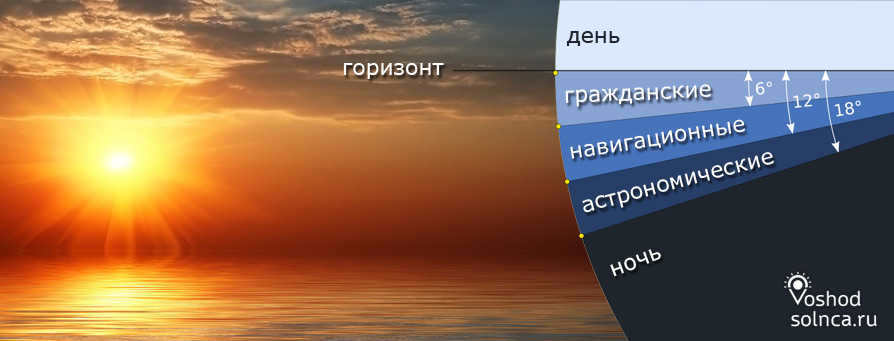
Every day we witness a variety of atmospheric phenomena. Often, we don’t ponder over their characteristics and essence. However, upon closer inspection, we can discern that many of these phenomena are far more intriguing than they initially appear. Twilight serves as a prominent example.
What exactly is twilight? It is a term that encompasses two distinct time periods:
- The interval between apparent sunset and the onset of nightfall;
- The period between the onset of nightfall and the visible sunrise.
Thus, we have provided an explanation for what twilight entails. However, it is worth noting that twilight can be further categorized into three types:
Throughout this article, we will delve into the distinctive characteristics of each variety of twilight.
Civil dawn
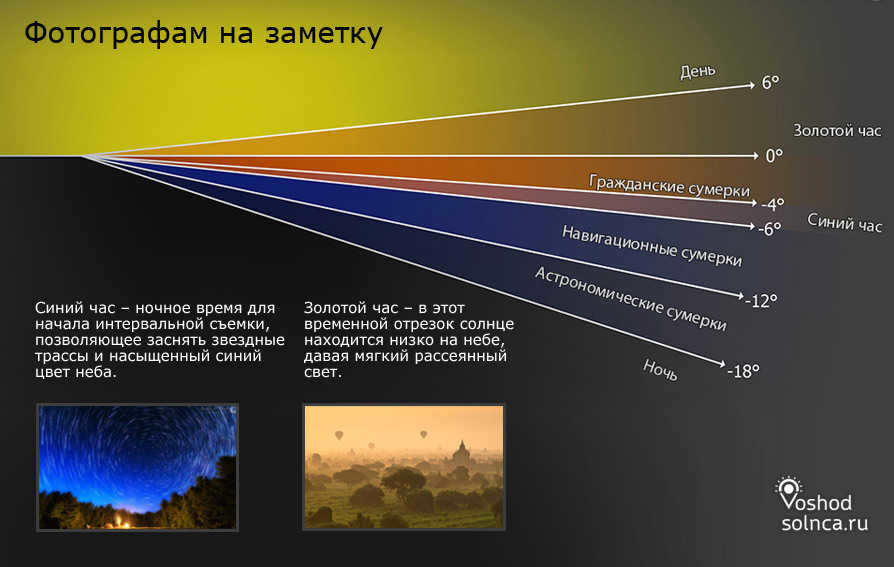
The picture above provides information about the phenomenon known as the “blue hour” and the “golden hour”.
Civil twilight begins right after sunset and ends when the center of the Sun is 6 degrees below the horizon. This type of twilight is the brightest, making it difficult to see small stars in the sky. However, under favorable atmospheric conditions, it is possible to spot the brightest celestial bodies. For example, during a clear sky and the period of civil twilight, Venus can be observed without the need for optical devices.
During this particular time frame, it is feasible to observe all earthly objects nearly as clearly as during the day. As a result, the commencement of civil twilight can occur in the morning, while the completion of outdoor activities can take place in the evening. Interestingly, this is the reason why it is referred to as civil twilight – it provides sufficient visibility without the need for additional lighting.
In certain latitudes, civil twilight can persist throughout the entire night. In other words, the evening twilight gradually transitions into morning twilight instead of a complete night. This occurrence is commonly known as white nights. In Russia, white nights can be experienced in St. Petersburg, Perm, Yakutsk, Vorkuta, and several other cities.
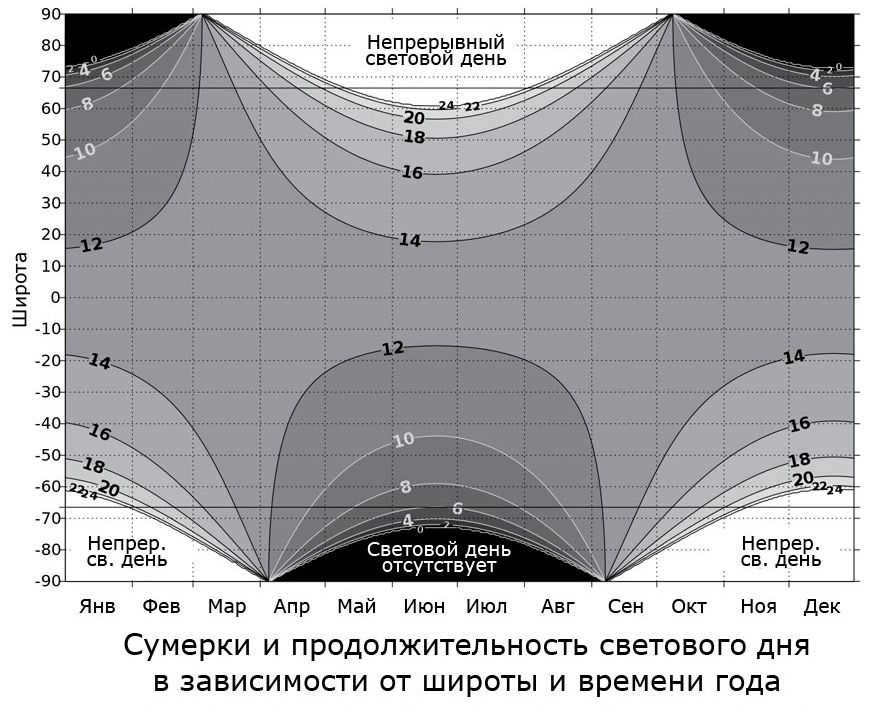
After the evening civil twilight ends, the navigational twilight begins. It can also be observed before the morning civil twilight begins.
During this time, the Sun is located 6-12 degrees below the horizon line. In navigational twilight, you can faintly make out the shapes of land objects. However, without artificial light, it’s impossible to see their details or discern the colors of objects. Because of this, field work is not conducted without the use of lighting devices in these conditions.
However, during this period, you can see all navigational stars, and the horizon line is still visible. This allows ship navigators to use a sextant to measure the angles between the horizon and the stars, hence the term “navigational” twilight.
Military forces frequently initiate attacks during the time of navigational twilight. The reason behind this strategy is that they are least likely to be detected by the enemy during this specific period of time.
Definition of astronomical twilight

Astronomical twilight refers to the period of time when the Sun is positioned 12-18 degrees below the horizon. This phase allows astronomers to observe a wide range of celestial objects, including both large planets and stars, as well as smaller luminaries. However, objects with a faint and diffuse luminescence can only be seen during astronomical night.
It is worth noting that the distinction between night and astronomical twilight is primarily understood by those who specialize in the study of celestial luminaries. For the average observer, the transition from astronomical twilight to night is usually imperceptible and is simply perceived as part of the night.
We trust that within this article you have discovered a comprehensive response to the query of what twilight entails. It is worth noting, however, that the duration of twilight as a whole, as well as each individual period within it, varies significantly depending on the latitude at which it is observed.
Twilight refers to the period of time between night and sunrise, as well as between sunset and nightfall. During this period, the Sun is already (or still) positioned below the horizon and therefore invisible. However, there are still apparent indications of sunset (or dawn) due to the scattering of sunlight in the Earth’s upper atmosphere.
Our planet Earth is enveloped by a dense layer of air, known as the atmosphere. It is this atmospheric layer that continues to emit light after sunset, thus giving rise to twilight on Earth. The atmosphere shines because it is illuminated by the rays of the sun that has already descended below the horizon.
Twilight is the period between sunset and the beginning of complete darkness, known as evening twilight, as well as the period between the end of complete darkness and sunrise, known as morning twilight. After the Sun dips below the horizon, a portion of the sky remains lit up due to the scattering of sunlight in the upper atmosphere. Initially, the illumination decreases rapidly and then at a slower pace.
The length of twilight varies depending on the latitude, with higher latitudes experiencing longer twilight periods. Additionally, the duration of twilight is influenced by the season and weather conditions. The longest twilight occurs during the summer and winter solstices on June 22 and December 22, respectively, while the shortest twilight occurs during the spring and autumn equinoxes on March 21 and September 23. Throughout twilight, the level of illuminance, measured in lux, undergoes almost a billion transformations.
The start of civil twilight occurs at sunset, when the illuminance is around 1000 lux, and it concludes when the Sun is at an angle of 6-8° below the horizon, causing the illuminance to decrease to 1.4 lux.
Nautical twilight begins after civil twilight ends, and it ceases when the Sun is 12° below the horizon, resulting in an illuminance of 0.006 lux. During nautical twilight, the illumination is insufficient to differentiate unlit objects on the shore from the sea, but the coastline can still be discerned.
Astronomical twilight commences once nautical twilight concludes and concludes as soon as the Sun descends beneath the horizon line at 18° (illumination diminishes to 0.0001-0.00001 lux) and the blue sky vanishes entirely. This variety of twilight is referred to as astronomical twilight because it is during this period that the illumination reaches a level enabling astronomers to embark on their task of examining the nocturnal heavens, although the optimal time for astronomical observations is during absolute darkness.
From a technical standpoint, twilight refers to the time period before sunrise and after sunset. During this time, the upper atmosphere provides natural light by reflecting some of the direct sunlight to the Earth’s surface.
There are different types of twilight, including civil, navigational, and astronomical twilight.
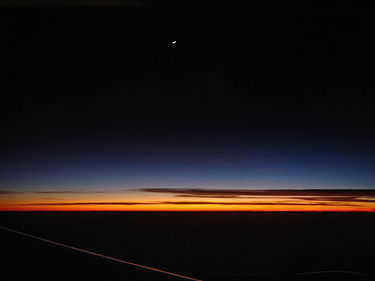
Twilight varies depending on the position of the Sun in relation to the horizon. There are three different types of twilight: civil twilight (the brightest form of twilight, during which the brightest stars can be seen), navigational twilight (where it is difficult to read without additional light), and astronomical twilight (occurring before or after astronomical night, when all stars are visible).
| Night | >18° [1] |
| Astronomical twilight | 12—18° |
| Navigational twilight | 6—12° |
| Civil twilight | 0—6° |
| Day | Sun above the horizon |
The period of civil twilight
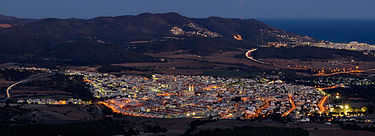
During civil twilight, the horizon is easily seen and land objects can be easily distinguished without the need for artificial lighting.
Civil twilight is the most illuminated stage of twilight, starting from the moment the Sun becomes visible as it sets below the horizon line and continuing until the center of the Sun drops below the horizon line by 6 degrees.
Civil twilight can also be defined as a period when, under favorable atmospheric conditions, there is enough light to clearly see landmarks; during the morning at the beginning or in the evening at the end of civil twilight, the horizon line is visible and, under favorable atmospheric conditions, the brightest stars can be clearly seen.
When it’s twilight, the ability to perceive the color of objects in natural light diminishes.
Twilight for navigation

Navigational twilight in St. Petersburg occurs one month after the summer solstice, with the sun positioned 9°14′ above the horizon.
This phase of twilight is characterized by relatively bright lighting, as the center of the sun remains below the horizon within a range of 6 to 12°.
It is commonly accepted that during navigational twilight, the natural illumination is sufficient for ship navigators to rely on shore objects for navigation purposes, especially when the ship is in close proximity to the shore.
During the summer solstice, the period of navigation twilight extends throughout the night in locations above 54° latitude, including cities such as Moscow, St. Petersburg, Kaliningrad, Nizhny Novgorod, Kazan, Omsk, Ufa, Perm, Yekaterinburg, Novosibirsk, Krasnoyarsk, and other cities in these regions. In other countries, this phenomenon occurs partially in Kazakhstan, Mongolia, China, Belarus, Poland, Germany, Great Britain, Canada, and the United States, while in Latvia, Estonia, Lithuania, Finland, Sweden, Norway, Denmark, and Iceland it occurs completely. In the Southern Hemisphere, navigation twilight occurs in the southern territories of Argentina and Chile.
However, this natural lighting is not sufficient for normal human activity, as the illumination outdoors resembles night lighting rather than evening lighting in the traditional sense. Therefore, artificial lighting is necessary in the streets of these settlements.
Astronomical twilight
Astronomical twilight refers to the period when the Sun is positioned between 12° and 18° below the horizon. Many casual observers notice that the entire sky appears to be completely dark, even at the very beginning of astronomical twilight in the evening or late morning. During this time, astronomers are able to easily observe celestial objects such as stars, and faintly scattering objects like nebulae and galaxies can also be clearly visible between astronomical twilight and astronomical night. However, to the average observer, astronomical twilight is often indistinguishable from night.
The formulas [2] are used to calculate the duration (t) and declination of the Sun (δ) when twilight is at its shortest.
Length of twilight
The length of twilight is determined by the latitude of the location and the time of year. It is important to note that in areas near the poles, civil twilight can last the entire night from September through March.
The length of twilight before sunrise and after sunset is highly dependent on the latitude of the location. In regions near the poles, if there is any twilight, it can last for several hours continuously. However, at the poles, there is no twilight for a month before and after the winter solstice. In these areas, twilight can last for up to two weeks. On the other hand, at the equator, twilight only lasts for about twenty minutes. This is because in regions with low latitude, the Sun appears to move perpendicular to the observer’s horizon. Additionally, the speed of the Earth’s rotation is highest at the equator and decreases as the latitude increases. Therefore, at the equator, a specific location will pass through all twilight zones directly and quickly. As we move towards the circumpolar regions, the Sun’s disk will be at a smaller angle and will sink below the horizon more slowly, resulting in a longer time for a given point on Earth to pass through the different twilight zones. In temperate latitudes, twilight is shortest during the equinoxes, slightly longer during the winter solstice, and much longer in late spring and early summer.
- The time of civil twilight in St. Petersburg, Anadyr, Arkhangelsk, Vorkuta, Murmansk, Naryan-Mar, Norilsk, Yakutsk, Tampere, Umeå, Trondheim, Torshavn, Reykjavik, Nook, Whitehorse, and Anchorage;
- The time of navigational twilight in Petropavlovsk, Magadan, Moscow, Vitebsk, Vilnius, Riga, Tallinn, Veyherovo, Flensburg, Helsinki, Stockholm, Copenhagen, Oslo, Newcastle-upon-Tyne, Glasgow, Belfast, Grand Prairie, Juneau (Alaska), Ushuaia, and Puerto Williams;
- The time of astronomical twilight in Astana, Kiev, Kharkov, Minsk, Warsaw, Kosice, Cvetl, Prague, Berlin, Paris, Luxembourg, Amsterdam, London, Cardiff, Dublin, Bellingham (Washington), Rio Gallegos, and Punta Arenas.
Alternative Worlds
The duration of twilight on Mars is longer compared to Earth, lasting up to two hours before sunrise or after sunset. The presence of dust particles in the upper atmosphere causes the scattering of light towards the darker side of the planet. A similar twilight effect can also be observed on Earth following significant volcanic eruptions.
Chances are, the concept of twilight is familiar to most people. It has gained even more attention recently due to its portrayal in a popular film. However, in reality, twilight is a common astronomical phenomenon that occurs on a daily basis in the mid-latitudes.
Understanding Twilight
Twilight is defined as the period when the sun has set below the horizon but it is not completely dark yet. It serves as a transitional phase between daylight and nighttime. During twilight, the sun has already disappeared from view, but darkness has not yet taken over, making it a unique astronomical occurrence. It occurs in the morning before the sun rises above the horizon and in the evening immediately after it sets. This gives rise to the distinction between morning twilight and evening twilight. Additionally, twilight can also refer to reduced illumination during the day, such as when dense thunderclouds or a solar eclipse occur.
There are additional definitions for the term. Twilight can refer to a dim illumination in a space. In a metaphoric sense, it is also employed in psychiatry to describe a state of consciousness that is blurred. Moreover, in the fields of political science and historical science, twilight can signify a phase of decline in any given system.
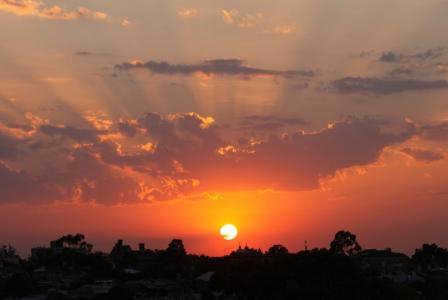
Understanding Twilight
Twilight is a term commonly used to describe an astronomical occurrence. While many are familiar with the concept, not everyone comprehends the specific events that take place during this time. What causes the difference in lighting between day and night? As the sun dips below the horizon, its rays continue to illuminate the clouds and upper atmosphere, preventing complete darkness on Earth. The reflected sunlight provides a level of illumination during twilight.
There is often a lot of discussion about evening twilight – the time immediately following sunset, as well as morning twilight – the period before sunrise. However, science has also identified other variations of this phenomenon. This categorization takes into account the position of the sun’s center in relation to the horizon. The types of twilight that are recognized include:
This classification may seem arbitrary, but it is based on the intensity of light. Civil twilight is named as such because during this time, it is still fairly bright, allowing for various activities and even reading. Navigational twilight is the best time to take navigational measurements, as both the stars and the horizon are visible. Lastly, astronomical twilight is ideal for observing celestial objects.
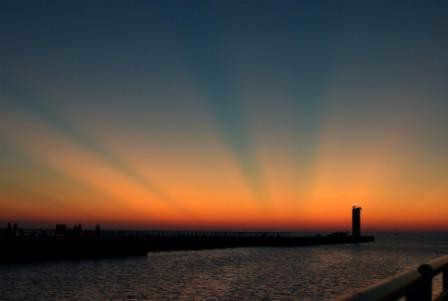
Types of Twilight
Twilight is a well-known phenomenon, but not everyone is aware that it can be divided into three distinct types. While this division is somewhat arbitrary, there are specific parameters that define each type of twilight.
- Civil twilight occurs immediately after sunset or just before sunrise, when the angle between the center of the sun and the horizon is 6-8 degrees. During this time, the lighting is dim, but it is still possible to perform tasks such as reading. Objects are clearly visible and the horizon line can be seen. The concept of civil twilight is often used in legislation, such as determining when headlights should be turned on in vehicles. However, it is based on the time after sunset rather than the angle of the sun. Typically, civil twilight lasts for 20-30 minutes.
- When the angle of the sun relative to the horizon is between 6 and 12 degrees, the stars become visible and the horizon line is still distinguishable. This time is perfect for navigational measurements. However, the illumination during navigational twilight is insufficient for regular human activities, so cities use street lights. The military also utilizes this concept in operation planning.
- Astronomical twilight occurs when the sun drops below 12 degrees. To an ordinary person, the dark sky is indistinguishable from the night sky. However, this is the ideal time for observing celestial objects. Stars, nebulae, and galaxies are clearly visible, although this may vary depending on cloud cover, latitude, and location. In major cities, astronomical observations are challenging due to artificial light pollution.

What is the duration of twilight
The duration of the period between night and day varies depending on the geographical latitude. Several factors influence the length of twilight, including latitude, time of year, cloud coverage, and even the weather conditions. The shortest duration of twilight occurs at the equator, where complete darkness sets in only 20-25 minutes after sunset. As one moves closer to the north, the duration of twilight increases. For instance, in St. Petersburg, there is a period when evening twilight blends with morning twilight, creating the phenomenon known as white nights. Beyond the Arctic Circle, the transition between polar night and polar day can last for several days.
Moreover, the length of twilight can differ because of different weather conditions and atmospheric events. For instance, this period becomes longer when there is a significant amount of dust or moisture in the air, along with high clouds. Additionally, the duration of twilight also increases during the summer and winter solstice. However, typically in the central region of Russia, twilight lasts between 30 to 60 minutes.

How this phenomenon affects individuals
Many view this phenomenon as extraordinary and enchanting. As a result, twilight has become a favorite subject for photographers and artists. The beauty of twilight is often depicted in various forms of art, literature, and cinematography. However, from a psychological perspective, this period is believed to have a negative impact on one’s mental state. The mind becomes unstable and many individuals experience feelings of anxiety. It is advised to avoid making important decisions or engaging in tasks that require deep concentration during twilight. Nevertheless, there are some individuals who find twilight to be a time of creative inspiration and a surge of energy.

Each day, we witness various atmospheric phenomena. Often, we don’t consider their peculiarities and nature. However, upon closer examination, we’ll discover that many of these phenomena are far more fascinating than they initially appear. Twilight serves as a prime example.
What exactly is twilight? It’s a term that encompasses two specific time periods:
- The period of time between the apparent sunset and nightfall;
- The period between nightfall and the visible sunrise.
So, we’ve now answered the question of what twilight is. However, it turns out that twilight is further divided into three distinct types:
In this article, we will delve into the distinctive characteristics of each type of twilight.
Civil dawn

Civil twilight occurs when the Sun sets and finishes once its center sinks below the horizon by 6 degrees. This particular type of twilight is the least dark. Because of this, it is difficult to make out small stars in the sky. However, if the atmospheric conditions are favorable, it is possible to observe the brightest celestial bodies. For instance, on a clear day during civil twilight, Venus can be seen in the sky without the need for optical devices.
During this particular time frame, it becomes feasible to observe all terrestrial objects with nearly the same clarity as during daylight hours. As a result, the onset of civil twilight can occur in the morning, while the conclusion of outdoor activities can be extended into the evening. This is precisely why it is referred to as civil twilight – it provides sufficient visibility without the need for supplemental lighting.
In certain latitudes, civil twilight can persist throughout the entire night. In essence, the transition from evening twilight to morning twilight gradually replaces the darkness of the night. This natural phenomenon is commonly known as white nights. In Russia, cities such as St. Petersburg, Perm, Yakutsk, Vorkuta, and several others are known to experience this captivating occurrence.

After the end of evening civil twilight, it is time for the navigational twilight to begin. It can also be observed before the start of morning civil twilight.
During this time, the Sun’s center is positioned 6-12 degrees below the horizon line. Navigational twilight allows for the faint outlines of land objects to become visible, although their details cannot be discerned without the aid of artificial light. Additionally, the colors of objects cannot be distinguished during this period. These factors make it impractical to conduct field work without the use of lighting devices in such conditions.
Naval forces often take advantage of navigational twilight to launch attacks. This is because it is the most challenging period for the enemy to detect their movements.
Definition of Astronomical Twilight
Astronomical twilight is a term used to describe the period of time before sunrise and after sunset when the sun is between 12 and 18 degrees below the horizon. During this time, the sky is still illuminated, but the stars and other celestial objects become visible.
During astronomical twilight, astronomers and stargazers have the opportunity to observe and study the night sky. It is a time when the sky is dark enough to see faint stars and other objects, but still has some illumination from the sun, making it easier to navigate and set up telescopes and other equipment.
Astronomical twilight is different from civil twilight, which is the period of time when the sun is between 6 and 12 degrees below the horizon. Civil twilight is the time when there is still enough light to carry out outdoor activities without artificial lighting.
Understanding the different levels of twilight is important for astronomers and anyone interested in observing the night sky. Astronomical twilight provides a unique opportunity to explore and appreciate the wonders of the universe.

Astronomical twilight refers to the period of time when the center of the Sun is 12-18 degrees below the horizon. This phase allows astronomers to begin their observations of various celestial objects. During astronomical twilight, not only large planets and stars are visible, but also smaller luminaries. However, objects with faint and diffuse luminescence can only be seen during astronomical night.
For those who specialize in the study of celestial luminaries, the distinction between night and astronomical twilight is clear. However, for the average observer, the transition from astronomical twilight to night is indistinguishable. In other words, they perceive it as part of the night.
We trust that this article has provided you with a comprehensive explanation of the concept of twilight. It is worth noting that the duration of twilight, both overall and for each of its stages, varies significantly depending on the observer’s latitude.
Chances are, most individuals are familiar with the concept of twilight. This term has gained popularity, particularly due to a well-known film. However, in reality, twilight is simply a regular astronomical phenomenon that occurs daily in the mid-latitudes.
Twilight: Exploring the Transition Between Light and Darkness
Twilight, also known as the “in-between” period, refers to that magical time of day when the sun has already dipped below the horizon, yet complete darkness has not yet settled in. It is a unique astronomical phenomenon that occurs both in the morning, before the sun rises, and in the evening, immediately after it sets.
During twilight, the world is bathed in a soft, ethereal glow, as if suspended between day and night. It is a time of transition and beauty, when the sky is painted with hues of pink, orange, and purple. The landscape takes on a mysterious quality, with shadows elongating and objects becoming silhouettes against the fading light.
Twilight has captured the imagination of artists, poets, and romantics throughout history. It symbolizes the fleeting nature of time and the delicate balance between light and darkness. It is a moment to pause, reflect, and appreciate the ephemeral nature of life.
In addition to its poetic allure, twilight also has practical implications. It can serve as a guide for navigators and photographers, providing a unique window of opportunity for capturing stunning images. Twilight can also affect our daily lives, as reduced illumination during the day can occur due to factors like dense thunderclouds or a solar eclipse.
So next time you find yourself caught between day and night, take a moment to embrace the enchantment of twilight. It is a time of magic, mystery, and the beauty of transition.

Understanding the Phenomenon of Twilight
Twilight is a term that is commonly used to describe various phenomena, but its most frequent usage is in reference to an astronomical occurrence. While many people are familiar with the concept of twilight, not everyone fully comprehends what takes place during this time. What causes the lighting to differ from that of daytime or nighttime? The answer lies in the fact that although the sun has already dipped below the horizon, its rays continue to illuminate the clouds and upper atmosphere, preventing complete darkness on Earth. The reflected rays of the sun provide the illumination during twilight.
Evening twilight, which occurs immediately after sunset, and morning twilight, which happens prior to sunrise, are the most commonly discussed periods. However, the scientific community recognizes other variations of this phenomenon based on the position of the sun’s center in relation to the horizon. These variations include:
This classification is quite typical. The twilight types are named according to the level of brightness. Civil twilight is called so because it is almost bright at this time, allowing certain activities and even reading. Navigational twilight is the optimal time for taking navigational measurements since both the stars and the horizon line are visible, while astronomical twilight is ideal for observing celestial objects.

Varieties
Twilight is a well-known phenomenon, but not everyone is aware that it can be categorized into three different types. This categorization is arbitrary, although there are specific parameters that determine the different types of twilight.
- Civil twilight occurs immediately after sunset or just before sunrise. During this time, the angle between the center of the sun and the horizon is approximately 6-8 degrees. The lighting is low, but it is still possible to perform various tasks, including reading. Objects are visible with clarity, and the horizon line can be distinguished. The concept of civil twilight is often used in legal contexts, such as determining when headlights should be turned on for vehicles. Typically, civil twilight lasts for around 20-30 minutes after sunset.
- If the sun’s angle relative to the horizon is approximately 6 to 12 degrees, the stars become visible, but the horizon line is still distinguishable. This period is optimal for navigational measurements. However, the illumination during navigational twilight is insufficient for regular human activities. Hence, cities illuminate their streets with lights. This concept is also utilized by the military during operational planning.
- Astronomical twilight occurs when the sun descends below 12 degrees. To an average person, the dark sky is indistinguishable from the night sky. Nevertheless, this is the perfect time for observing celestial objects. Stars, nebulae, and galaxies are clearly visible. However, visibility also depends on factors such as cloud cover, latitude, and the observing location. For instance, astronomical observations are challenging in large cities due to artificial lighting.

What is the duration of twilight?
The length of twilight varies depending on different factors such as geographic latitude, time of year, cloud cover, and weather conditions. At the equator, twilight is the shortest, lasting only 20-25 minutes after sunset before complete darkness sets in. As you move closer to the north, the duration of twilight increases. In places like St. Petersburg, there are periods where evening twilight merges with morning twilight, known as white nights. Beyond the Arctic Circle, the time between polar night and polar day can last several days.
Moreover, the length of twilight can be altered by various weather conditions and atmospheric events. For instance, this period can be extended when there is a significant amount of dust or moisture in the atmosphere or when there are high clouds. Additionally, the duration of twilight is also prolonged during the summer and winter solstice. However, typically in the central region of Russia, twilight lasts for approximately 30 to 60 minutes.

The impact of this phenomenon on an individual
It is widely believed that such illumination is extraordinary and enchanting. As a result, twilight is adored by photographers and artists. It is frequently utilized in art, literature, and cinematography. However, in psychology, it is believed that this time negatively affects the human state. The mind becomes unstable, and many individuals experience anxiety. It is not advisable to make significant decisions or engage in tasks that require deep concentration at dusk. Nevertheless, for certain individuals, twilight represents a time of creative inspiration and a surge of energy.

However, the determination of twilight is not based on the amount of light, as one might assume, but rather on the position of the sun in relation to the horizon line, specifically its angular height. Different types of twilight are distinguished based on this parameter:
Civil twilight occurs when the sun is positioned above -6 degrees.
Navigational twilight occurs when the sun is positioned above -12 degrees.
Astronomical twilight occurs when the sun is positioned above -18 degrees.
Astronomical twilight is the longest type and encompasses the other two types.
When determining the timing of sunrise and sunset, which mark the end of morning twilight and the beginning of evening twilight, it is important to consider factors such as the size of the sun and various optical effects, including refraction and parallax. Taking these corrections into account, the angular altitude of the sun is assumed to be -0°50′ when calculating the timing of these events.
For instance, the period of time when the sun is at an altitude of -0°50′ to -18° is referred to as astronomical twilight.
This post was published on 02/01/2016 23:19 and is filed under Front Page. You can scroll to the bottom of the page and leave a comment.
Need more bukaff? Discover more!
Lunar Phase Calendar
Explore the lunar phase calendar for any date between 1000 AD and 9999 AD. In addition to calculating moon phases for specific days, I also offer other useful features.
Current Lunar Phase
As the moon revolves around the Earth, we witness the varying illumination of our celestial companion throughout a lunar month. This celestial motion determines the ever-changing phases of the moon.
Visit the shopshoker website to discover the locations of stores where you can purchase a stun gun in Moscow.
Twilight is a designated interval that occurs before dawn and after dusk, wherein the Earth’s upper atmosphere receives direct sunlight and reflects a portion of it back to the surface, providing natural illumination.
There are different types of twilight, including civil, navigational, and astronomical twilight.
Description
The text needs to be paraphrased while maintaining its uniqueness.

The position of the Sun relative to the horizon determines the different types of twilight. There are three subspecies of twilight: civil twilight, navigational twilight, and astronomical twilight.
| Night | >18° [1] |
| Astronomical twilight | 12—18° |
| Navigational twilight | 6—12° |
| Civil twilight | 0—6° |
| Day | Sun above the horizon |

In the period of civil twilight, the view of the horizon is easily discernible and objects on land can be distinguished without the need for artificial illumination.
Civil twilight refers to the brightest phase of twilight, which occurs from the time the Sun becomes visibly positioned behind the horizon line until the center of the Sun drops below the horizon line by 6°.
Civil twilight can also be characterized as a time when, under favorable atmospheric conditions, there is ample light to clearly observe landmarks; during the morning at the start or in the evening at the conclusion of civil twilight, the horizon line is distinctly visible and, under favorable atmospheric conditions, the brightest stars can be clearly seen.
If civil twilight persists throughout the night, it is known as a white night. During the summer months, north of the Arctic Circle, the Sun remains above the horizon throughout the entire day, creating a phenomenon known as a polar day.
During twilight, the perception of colors in natural light gradually diminishes.
Twilight for navigation

Navigational twilight occurs in St. Petersburg one month after the summer solstice, with the sun positioned 9°14′ above the horizon.
Navigational twilight, which spans from 6 to 12° below the horizon, is a relatively bright phase of twilight.
It is commonly held that this particular phase of twilight provides enough natural light for ship navigators to use shore objects as reference points when sailing near the coastline.
During the summer solstice, the navigation twilight extends throughout the entire night in latitudes above 54°, which includes cities like Moscow, St. Petersburg, Kaliningrad, Nizhny Novgorod, Kazan, Omsk, Ufa, Perm, Yekaterinburg, Novosibirsk, Krasnoyarsk, and other cities in these latitudes. It is also partially present in countries like Kazakhstan, Mongolia, China, Belarus, Poland, Germany, Great Britain, Canada, and the USA, and completely present in Latvia, Estonia, Lithuania, Finland, Sweden, Norway, Denmark, and Iceland. In the Southern Hemisphere, it can be observed in the southern territories of Argentina and Chile.
However, this natural lighting is insufficient for regular human activities as it resembles night lighting more than evening lighting. Therefore, artificial lighting is necessary in the streets of settlements.
During the early stages of dawn or late stages of dusk, when the weather conditions are favorable and there is no other source of light, one can vaguely make out the basic shapes of objects on land. However, complex outdoor activities are not feasible during this navigational twilight, and the horizon appears blurry. The military also utilizes this period of twilight. The acronyms BMNT (begin morning nautical twilight) and EENT (end evening nautical twilight) are used and considered when planning military operations. Military units can enhance their security by taking into account BMNT and EENT. This practice was partly influenced by the lessons learned from the Franco-Indian War, during which both sides launched attacks during these time periods.
Astronomical twilight refers to the period when the Sun is positioned between 12° and 18° below the horizon. At the onset of astronomical twilight in the evening or late morning, most casual observers perceive the entire sky as already being completely dark. During this time, astronomers have the ability to conduct observations of celestial luminaries such as stars. Additionally, faintly scattering objects like nebulae and galaxies can also be clearly visible between astronomical twilight and astronomical night. However, to the average observer, astronomical twilight is indistinguishable from night.
The formulas [2] are used to calculate the shortest duration (t) and declination of the Sun (δ) during which twilight will occur.
Length of the twilight period
The length of twilight is determined by the latitude of the location and the time of year. It is important to note that in areas near the poles, from September to March, civil twilight can last throughout the entire night.
The length of the period of dim light before sunrise and after sunset greatly depends on the latitude of the location. In regions near the poles, there may be no twilight for a month before and after the winter solstice. In these areas, twilight can last for up to two weeks. On the other hand, at the equator, twilight may only last for about twenty minutes. This disparity is due to the fact that in regions with lower latitudes, the path of the Sun appears to be perpendicular to the observer’s horizon. Additionally, the speed at which the Earth rotates is highest at the equator and decreases as latitude increases. Consequently, a location on the equator will pass through all the twilight zones directly and swiftly. As we move closer to the polar regions, the Sun’s disk will be at a smaller angle and will sink below the horizon more slowly, causing a longer duration of twilight. In temperate latitudes, twilight is shortest during the equinoxes, slightly longer during the winter solstice, and much longer in late spring and early summer.
- Civil twilight occurs in St. Petersburg, Anadyr, Arkhangelsk, Vorkuta, Murmansk, Naryan-Mar, Norilsk, Yakutsk, Tampere, Umeå, Trondheim, Torshavn, Reykjavik, Nook, Whitehorse, and Anchorage;
- Navigational twilight is observed in Petropavlovsk, Magadan, Moscow, Vitebsk, Vilnius, Riga, Tallinn, Veyherovo, Flensburg, Helsinki, Stockholm, Copenhagen, Oslo, Newcastle-upon-Tyne, Glasgow, Belfast, Grand Prairie, Juneau (Alaska), Ushuaia, and Puerto Williams;
- Astronomical twilight can be seen in Astana, Kiev, Kharkov, Minsk, Warsaw, Kosice, Cvetl, Prague, Berlin, Paris, Luxembourg, Amsterdam, London, Cardiff, Dublin, Bellingham (Washington), Rio Gallegos, and Punta Arenas.
Alternative Worlds
The duration of twilight on Mars is longer than that on Earth, extending up to two hours before sunrise or after sunset. The presence of dust particles in the upper atmosphere causes light to scatter towards the darker side of the planet. This phenomenon is reminiscent of the twilight observed on Earth following significant volcanic eruptions.


Twilight is frequently used interchangeably with dusk or dawn, however, each of these phrases has its own distinct meaning. Furthermore, there exist three categories of dusk – civil, nautical, and astronomical. Let us comprehend these terms definitively, as well as grasp the concept of light pollution.
What does astronomical twilight mean?
Astronomical twilight refers to the time period when the Sun is below the horizon line, but its indirect light still partially brightens the sky. This phenomenon happens due to the Earth’s atmosphere, which scatters and reflects sunlight, allowing some illumination even after the Sun has set.
There are three categories of twilight – civil, navigational, and astronomical. They occur in sequence; twilight is classified into different categories based on the position of the geometric center of the Sun below the horizon:
- Civil twilight: 0-6 degrees
- Navigational twilight: 6-12 degrees
- Astronomical twilight: 12-18 degrees
The time when the Sun falls below 18 degrees is referred to as night.
What is the duration of twilight?
The length of twilight varies depending on the location, time of year, and weather conditions. The shortest twilight can be observed at the equator, where darkness falls 24 minutes after sunset. On the other hand, at the poles, twilight can last for approximately six weeks.
Understanding Dusk, Sunset, and Dawn
Dusk and dawn are the moments when the center of the Sun is positioned below the horizon line, while twilight refers to the time interval between these points. For instance, when the Sun is 18° below the horizon, it is referred to as astronomical sunset or dawn. The interval between 12 and 18° below the horizon is known as astronomical twilight.
In addition, there are three types of dawn and dusk based on the degree of the Sun’s immersion below the horizon line:
What is the timing of astronomical twilight?
The timing of twilight varies across different regions of the world, so there is no universal time for its onset. However, there are tools available to help determine when astronomical twilight occurs. One option is to use a website or app, such as the Time and Date website, which provides detailed information on sunset and sunrise times for your specific location.
There are also several apps designed specifically for photographers and outdoor enthusiasts that can assist with planning and visualizing future photos. Examples include Photopills, Sun Surveyor, and the Photographer’s Ephemeris. Our own app, Ephemeris, is also a valuable tool for photo planning. It not only displays the exact timing of civil, navigational, and astronomical twilight, but also calculates the start and duration of the golden hour, provides data on the visibility of the Milky Way, and offers other useful information.
When is the optimal time to capture photos during twilight?
The period of civil twilight
This phase is the most illuminated and is often what people envision when they think of twilight. Civil twilight occurs right before sunrise or after sunset. During this time, the horizon is clearly visible and only the brightest stars and planets can be seen in the sky. In many countries, it is required by law for street lights and car headlights to be turned on during this period.
Immediately after sunset, the sky remains bright and displays a variety of colors. To capture the array of hues in the sky, it is recommended to start photographing during the very beginning of civil evening twilight.
This stage is known as the second phase, where the horizon line becomes less distinguishable. The origin of this concept dates back to the past, when sailors relied on the stars for navigation. During the period of navigational twilight, a greater number of stars become visible, allowing one to determine their location based on their positions.
Meanwhile, urban areas are already bathed in artificial light during this time, making navigational twilight ideal for capturing cityscapes through photography. As for astrophotography, there is an opportunity to capture the full moon as it rests on the horizon. This presents a chance to photograph dark silhouettes juxtaposed against the moonlit backdrop.
Astronomical twilight
When the sky is almost completely dark and the horizon is barely distinguishable, astronomical twilight occurs. The Milky Way becomes visible in the sky, and even faint stars and planets can now be observed with the naked eye (unless the Moon is illuminating the sky). However, galaxies, nebulae, and star clusters are still best observed during complete darkness, after the Sun has dropped more than 18° below the horizon.
This is a great opportunity for capturing photographs and making observations of celestial bodies. If the Milky Way is visible in your area (check with the Ephemeris for the specific time), try taking pictures of this awe-inspiring galaxy.
What is light pollution?
Light pollution, also known as backlighting, refers to the presence of excessive or unwanted artificial light. It is a common issue that has various negative effects. For instance, one of its consequences is the decreased visibility of celestial objects during astronomical observations. In urban areas, even the brightest stars are barely visible, making it almost impossible to see constellations and planets. As a result of excessive light, approximately one-third of the global population is unable to see the Milky Way in the night sky!
Due to these reasons, articles on stargazing often recommend going far away from cities, as the night sky in urban areas is typically ten times brighter than in natural conditions.
Night sky glare occurs when light fixtures project light upward into the atmosphere. This light scatters and reflects, ultimately returning to Earth and obstructing our view of the night sky. This phenomenon is not limited to the immediate vicinity of the light source; its effects can be felt even at a distance.
To summarize, twilight refers to a period of time, while sunset and dawn are specific moments. Civil twilight is not ideal for stargazing, but during navigational twilight, you can already observe a greater number of stars. The best time to look for stars and planets is during astronomical twilight, while deep space objects are best observed at night. Remember to avoid areas with city lights, as they will limit your visibility to only the Moon and the brightest stars, at most.
What is twilight?
Twilight can occur both in the morning and in the evening. In the morning, it signifies the gentle shift from night to day, while in the evening, it represents the opposite – the transition from day to night. Twilight can also refer to the period when the sun is still above the horizon line, but the natural illumination is diminished due to various natural occurrences such as a solar eclipse or thick thunderclouds. However, it is important to note that this particular usage of the word is more of an artistic expression rather than a strictly scientific definition.
What is twilight?
Twilight is a time of day that is divided into three stages: civil, navigational, and astronomical twilight. These stages are determined by the position of the sun in relation to the horizon. Different opinions exist regarding the specific duration and characteristics of each type of twilight.

Based on one categorization system, these three varieties of twilight happen consecutively; based on another system, they all coincide but vary in their completion time: civil twilight concludes first, followed by navigational twilight, and lastly astronomical twilight. In Russia, the customary approach is to employ the initial method of classifying twilight.
It is crucial to understand that this classification system is somewhat arbitrary. It is widely accepted that during civil twilight, one can carry out various tasks outdoors without the need for artificial lighting. Navigational twilight is characterized by the visibility of stars, although the horizon line remains discernible, enabling navigational calculations while piloting a vessel. Astronomical twilight, on the other hand, presents a sky that appears completely dark, facilitating astronomical observations of celestial bodies like stars with ease. However, objects such as nebulae are still not sufficiently defined to be observable without the aid of telescopes.
In certain jurisdictions, the concept of civil twilight is considered in the formulation of laws. For instance, in countries where nighttime theft carries a harsher penalty than daytime theft, the period of civil twilight may or may not be included within the definition of nighttime according to legal standards. In practical application, the duration of civil twilight is determined not by the position of the sun relative to the horizon, but rather by a predetermined period of time (typically 20-30 minutes) after sunset or before sunrise.
What impact does twilight have on the human mind?

From a psychological perspective, twilight represents a period when the human mind is at its most vulnerable and easily influenced. In practical terms, this means it is advisable to refrain from making important decisions or engaging in tasks that require heightened concentration during twilight.
Twilight can evoke a sense of vague unease in some individuals, while others may experience a heightened emotional state. Regardless of which category you personally identify with, it is important to recognize that twilight is simply a regular astronomical occurrence that can be waited out or even utilized to one’s advantage.
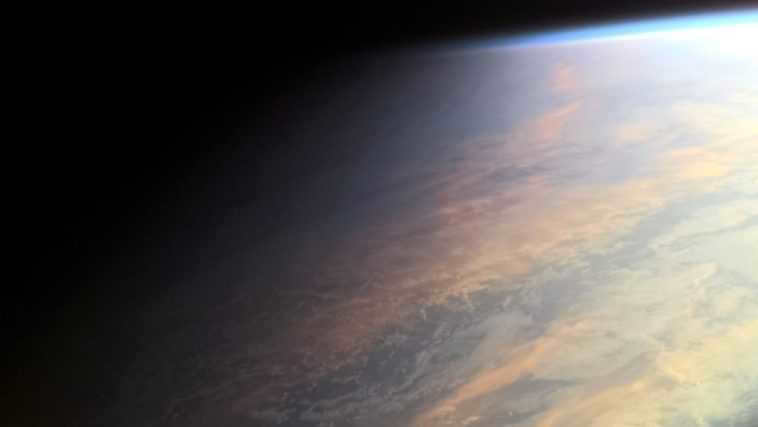

The terms twilight, dusk, and dawn are often used interchangeably, but they each have distinct meanings. Furthermore, there are three different types of dusk: civil dusk, nautical dusk, and astronomical dusk. It is important to grasp the nuances of these terms and also to understand the concept of light pollution.
Twilight is the phase that occurs after the Sun has dipped below the horizon line, but still casts a faint glow across the sky. This phenomenon is a result of the Earth’s atmosphere, which scatters and reflects light, providing illumination even in the absence of direct sunlight.
Twilight Varieties
A range of twilight exists, categorized as civil, navigational, and astronomical. These distinct types of twilight follow a specific order, depending on the position of the Sun’s geometric center below the horizon:
- Civil twilight: 0–6 degrees
- Navigational twilight: 6–12 degrees
- Astronomical twilight: 12–18 degrees
Once the Sun dips below 18 degrees, it marks the beginning of the night.
What is the duration of twilight?
The length of twilight can vary depending on your location, the time of year, and the weather conditions. At the equator, darkness typically falls about 24 minutes after sunset, making it the shortest twilight. On the other hand, at the poles, twilight can last for approximately six weeks, making it the longest twilight.
Understanding Dusk, Sunset, and Dawn
Dusk and dawn are specific moments when the center of the Sun is positioned below the horizon line. Twilight refers to the time period between these moments. For instance, when the Sun is 18° below the horizon, it is referred to as astronomical sunset or dawn. The interval between 12 to 18° below the horizon is known as astronomical twilight.
There are also three types of dawn and dusk, which are determined by the degree to which the center of the Sun is submerged below the horizon line.
When does astronomical twilight occur?
The timing of twilight varies across different regions, making it impossible to pinpoint a universal start time. So how can you determine when astronomical twilight occurs? Turn to a website or app. One such resource is the Time and Date website, which offers comprehensive sunset and sunrise information tailored to your specific location.
There are also several apps available, including Photopills, Sun Surveyor, and the Photographer’s Ephemeris. These handy tools are not only beneficial for photographers looking to plan and visualize future shots, but they also provide precise details about civil, navigational, and astronomical twilight times. Additionally, they calculate the golden hour’s duration and timing and offer data on Milky Way visibility and other useful information.
Twilight during civil hours
This phase is characterized by its brightness and is commonly associated with twilight. Civil twilight occurs immediately before sunrise or after sunset. During this time, the horizon is clearly visible and only the most luminous stars and planets can be seen in the heavens. In numerous countries, regulations stipulate that street lights and car headlights must be turned on during this period.
Following sunset, the sky retains its brightness and displays a multitude of vibrant colors. To capture the diverse shades in the sky, it is advisable to witness the initial moments of civil evening twilight.
Twilight for Navigation
This stage marks the point when the horizon line becomes less distinguishable. The concept originates from a time when sailors relied on the stars for navigation. During this phase, you can observe a greater number of stars and determine your location based on their positions.
During navigational twilight, urban areas are already fully lit with artificial light, making it an ideal time for city photography. For astrophotography enthusiasts, this phase presents an opportunity to capture the full moon on the horizon, allowing for the creation of stunning images featuring dark silhouettes against the moonlit backdrop.
Astronomical twilight
When the sky is nearly completely dark and the horizon is barely visible, astronomical twilight occurs. The Milky Way starts to become visible in the atmosphere and even faint stars and planets can now be observed without the aid of a telescope (unless, of course, the Moon is lighting up the sky). However, galaxies, nebulae, and star clusters are still best observed during total darkness, when the Sun has already descended more than 18° below the horizon.
This is an ideal moment for capturing photographs and conducting observations of celestial objects. If you are able to spot the Milky Way in your location (consult the Ephemeris for the exact time), try to capture the beauty of this magnificent galaxy.
What is light pollution?
Light pollution, also known as backlighting, refers to the excessive or unwanted artificial illumination. It has various negative effects, one of which is reducing the visibility of celestial objects during astronomical observations. In urban areas, even the brightest stars are barely visible, making it nearly impossible to see constellations and planets. The excessive light in cities prevents about one-third of the global population from witnessing the beauty of the Milky Way in the night sky!
That is why articles about stargazing often recommend going far away from urban areas, as the average city sky is ten times more illuminated than usual.





